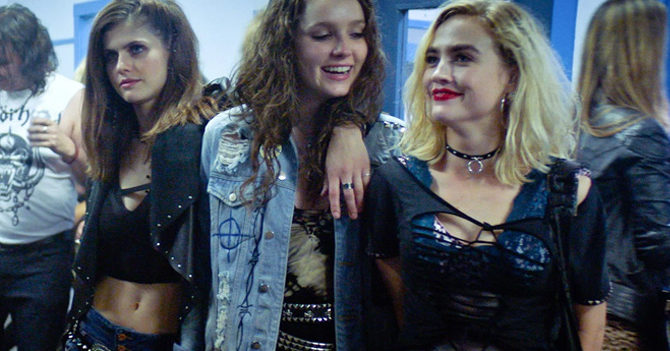The year is 1988. Floods of teenagers flock to a Midwestern heavy metal concert despite controversies sparked by unidentified Satanists on a murder spree and the region’s fearmongering Bible Belt. A trio of rowdy friends (Alexandra Daddario, Maddie Hasson, Amy Forsyth) have a run-in with a group of aspiring metal musicians (Keean Johnson, Logan Miller, Austin Swift). Both parties have a rocky start with each other, but the head-banging camaraderie in the air is enough to weaken their defences. After the concert, the guys and gals decide to continue the party at a nearby house, only to discover the true nature of each other.
We Summon the Darkness features typecast actors stepping out of their comfort zones in order to commit to madcap mayhem from director Marc Meyers (My Friend Dahmer). The film will work well in the long run for Alexandra Daddario, for instance, as suspicious films in the past (like Texas Chainsaw 3D, Baywatch, and The Layover) have treated the performer as mere eye candy. In Meyers’ movie, a film that Daddario also helped produce, the actor gets to flex her comedic chops with some twisted material that shows her range as a frightening, kooky screen presence. The other noteworthy actor is Johnny Knoxville of Jackass fame, who appears in a brief role as much beloved Pastor John Henry Butler. Knoxville’s signature charisma and confidence is channeled into a role that alludes to mental manipulation which, like Daddario, can be intimidating just as much as it can be purposely campy.
Besides some individual performances, We Summon the Darkness doesn’t conjure up much excitement. The film is pitched as a horror/comedy, but Meyers tries too hard to either scare his audience or make them laugh. Even the film’s 80s era is beaten into the ground with nonstop references. The movie resembles a thriller more than anything but, unfortunately, once the characters seclude themselves in the luxurious house, the movie plays it safe. Instead of upping the ante, it resorts to a standard cat-and-mouse formula. It’s efficient enough, but it’s hard to commend the movie when these genre traits are so deeply coded in this concept. It doesn’t involve much effort for the filmmakers to connect the dots.
The film also encounters an issue with revealing a twist early on. Since it’s such a good game changer for the story, the film has to keep the same surprising energy alive for the rest of the duration. The script (written by Alan Trezza) takes some big swings with characters becoming more dangerous and frantic, but the writing is stuck with a director who doesn’t want to play ball.
**********
Do You Tweet? Follow These Tweeple:
Addison Wylie: @AddisonWylie





Be the first to comment